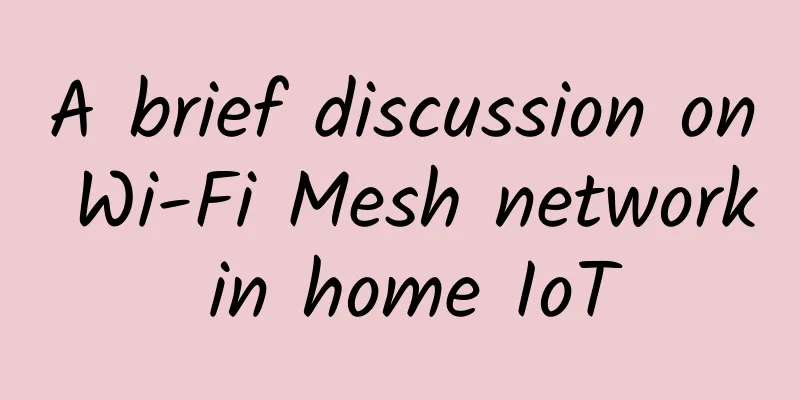A brief discussion on Wi-Fi Mesh network in home IoT

|
Author: Fan Deyang, unit: China Mobile Smart Home Operation Center Labs GuideIn recent years, more and more smart home devices have been pouring into ordinary people's homes. With the increase of smart home devices, such as audio, TV, washing machine, surveillance camera, lighting, automatic curtains, etc., connected to a home IoT network, it is often easy to cause network loading difficulties or even network abnormalities of the devices, and the remote control cannot be completed. So what is going on? After reading this article, you may have the answer. Part 01 Opportunities of Wi-Fi MeshThe addition of more and more smart home devices to the home IoT network often leads to device network anomalies, resulting in problems such as being unable to remotely control or view device status. The reason is that most traditional home IoT networks use a star structure, with only one ordinary router connected to N independent smart device nodes at the end, while the number of devices that can be connected to the IoT gateway is limited. As shown in Figure 1, when there are many device nodes and they run at the same frequency, signal conflicts may occur; in addition, when a device node cannot access the gateway due to an obstacle, the device will lose connection, unable to upload data, and unable to be controlled. Figure 1 Part 02 What is Wi-Fi Mesh NetworkThe so-called Wi-Fi Mesh network is a wireless mesh network, also known as a multi-hop network, as the name implies. As shown in Figure 2, in a Wi-Fi Mesh network, nodes are connected to each other wirelessly, each device node can also serve as a router, each node can receive or relay data to the next connected node, and each device node can communicate with one or more corresponding nodes. Therefore, the entire network does not rely on a single device node. Even if a node cannot be directly accessed due to a fault, it can still be accessed through other connected links in the network, which greatly improves the robustness of the network. Figure 2 Part 03 Features of Wi-Fi Mesh Network
Part 04 ConclusionAlthough Wi-Fi Mesh network technology still has some shortcomings, for example, the Wi-Fi Mesh network solutions of manufacturers on the market are all defined and designed by themselves, and there is no unified standard, which makes the routers between different manufacturers incompatible when building a Mesh network. However, given its advantages and with the continuous changes in Wi-Fi Mesh technology and the continuous standardization of industry standards, we look forward to more and more mature solutions for Wi-Fi Mesh in home IoT applications. |
<<: Google Fiber: 5 Gbps and 8 Gbps services coming early next year
>>: What exactly is the cache technology that supports high concurrency?
Recommend
Dr. Li Jin: Is building credibility “regardless of cost”?
[51CTO.com original article] June in Beijing is w...
Five disruptive features of 6G networks
The telecommunications industry is constantly pur...
How to build a strong network during the COVID-19 pandemic?
[[343306]] Maintaining a resilient network with m...
HPE Aruba Networking Launches Enterprise-Grade Private 5G Network to Simplify Deployment of Dedicated Cellular Networks
HPE (NYSE: HPE ) today announced the launch of HP...
What damage will it cause if the router at home is not turned off for a long time?
The network equipment such as routers has now bee...
The latest progress of LTE-5G deployment in Asia Pacific in July: 24 commercial 5G networks have been launched
Recently, GSA announced the latest progress of LT...
Use the PipedInputStream class and the PipedOutputStream class to learn about communication between pipe streams.
[[433836]] Hello everyone, I am a Java expert. Pr...
ProfitServer 50% off all VPS from $2.88/month, Hong Kong/Singapore/Russia/Spain/Netherlands/Germany and other data centers
ProfitServer is a foreign hosting company founded...
5G is not yet popular, so why are 4G phones now starting to have their speed limited?
I don’t know since when, but it feels like the cu...
How 5G will shape the future of construction
5G is an enabler that will deliver new capabiliti...
Virtono: New data center in Romania, 25% discount on all VPS starting at 11.21 euros per year
I received an email from Virtono two days ago. Th...
Good news for 5G! China ranks first in the world in 6G patents, and many countries are investing heavily to catch up
As a developing country, China's internationa...
What are the differences between WAN, LAN, PAN and MAN?
What is the difference between a wide area networ...
10 Ways to Use AI for Web Design
【51CTO.com Quick Translation】 Web design is const...









